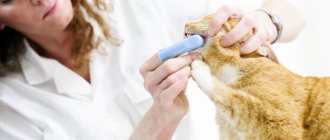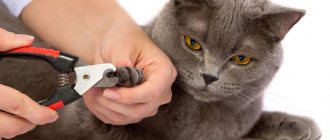If deviations from the norm are detected, you must call a veterinarian to your home. If the indicators are within acceptable limits, there is no cause for concern.
Many owners are hesitant to measure the temperature of their pets because they do not know how exactly this is done, or they are afraid of harming the animal. However, there is absolutely nothing to worry about here, since the process of measuring temperature is completely simple.
To carry out this procedure, use a standard medical thermometer. There are several types of thermometers: electronic, mercury, rectal.
What temperature is considered normal?
In an adult cat, this parameter should be in the range of 38-38.5°C. In a kitten, this figure is lower, and in newly born cubs, the body temperature ranges from 35.1 to 36.1 ° C. If necessary, the first measurement can be taken at one week of age.
Measuring a kitten's temperature
The following factors may affect temperature readings:
- age of the animal;
- individual characteristics (it is important to know what temperature is optimal for this particular cat);
- time of measurement (in the morning the readings are lower than in the evening);
- sleep state (temperature drops to 37°C);
- pregnancy (3-5 days before birth, body temperature drops by 1 degree);
- stress;
- binge eating;
- heatwave.
During the day, the parameters can change by 0.5 degrees.
If the thermometer shows less than 37.5 and above 40 degrees, but there are no symptoms of the disease, there is still a reason to urgently contact a veterinarian.
Note: If the kitten was born premature or very weak, its temperature may be so low that the cat will most likely lose interest in it and stop caring for it. In this case, it is necessary to create a warm microclimate in the place where the baby is.
It is noteworthy that the temperature of ordinary cats is almost the same as that of representatives of hairless breeds (for example, Sphynxes). But, since a body not covered with hair is noticeably warmer to the touch, many owners are mistaken about this point.
Sphinx
Which thermometer is better to use?
It is optimal to use an electronic rectal thermometer to measure the body temperature of your furry pet. It produces reliable results in a few seconds and causes less inconvenience to the animal than all other possible options.
This thermometer is easy to use. In how to measure a cat's temperature with an electronic thermometer, the most difficult part is inserting the tip of the thermometer into the rectum. This must be done as carefully as possible so as not to cause pain to the animal or damage the intestines.
Measurement methods
You can measure the temperature as accurately as possible using a special thermometer, which can be purchased at a veterinary pharmacy. However, an ordinary, human one is also suitable for this purpose.
Digital Thermometer
Considering that the only reliable measurement method is rectal, it is preferable to use an electronic thermometer rather than a mercury thermometer. Although the latter is considered more accurate, it is unlikely that your cat will calmly endure the 5-7 minutes it takes to take measurements.
The electronic gadget produces accurate results within a few seconds; its only drawback is its relatively high price.
Ear thermometer
Some, feeling sorry for their pet, use ear devices, but the accuracy of the results is questionable. The fact is that it is quite difficult to take measurements while meeting the necessary requirements. There is one more drawback of such a device - the high price tag, in comparison with other thermometers.
In what cases is measurement necessary?
There is a common belief that the main sign of fever in cats is a warm, dry nose. However, one should not rush to conclusions. This symptom may occur due to hot weather or appear during sleep.
This symptom is also observed in older pets - most often the cause is poor functioning of the glands responsible for moisturizing the surface of the nose. In this case, a cause for concern will be the presence of a number of other symptoms in addition to the indicated sign.
The following manifestations indicate changes in temperature indicators:
- the animal refuses to eat;
- the pet develops chills;
- the ears become hotter, the fur also heats up;
- the cat begins to avoid people;
- heartbeat and breathing become noticeably faster;
- activity decreases, behavior becomes passive;
- the animal vomits;
- there is dilation of the pupils;
- the mucous membrane and skin turn pale;
- discharge appears from the nose, eyes and ears;
- the pet is very thirsty.
Refusal to eat
Determining temperature indicators without using a thermometer
If there is an urgent need to determine the cat’s temperature, but you don’t have a thermometer at hand, you can use the following changed external signs of the animal to detect an increase in temperature:
- First of all, pay attention to the cat’s nose: in normal condition it should be damp to the touch and cool, if the temperature rises, the animal’s nose becomes dry and hot; however, there are some factors due to which the nose can be dry, and this will be considered within normal limits, for example, during active play, or during sleep, as well as in older cats;
- the most reliable sign of high temperatures is the third eyelid, which will stand out both in a sleeping animal and in a waking one;
- when the temperature changes, the cat may tremble, stop playing, lose appetite, and become more thirsty;
- at elevated body temperatures, the cat may experience diarrhea or vomiting; in any case, with these symptoms, it is better to contact a qualified specialist.
When the temperature changes, the cat may tremble
Why do cats get fevers?
Do you know that you can judge the temperature parameters of your four-legged friends without a thermometer? The following signs will help identify hyperthermia:
- The front part of the nose, called the earlobe, is the mirror. A healthy cat's earlobe is cool and slightly moist. As the temperature increases, it becomes dry and hot. The data will be objective only if the furry fidget is awake, but not running or jumping, but, for example, just resting. Indeed, during outdoor games and sleep, the tip of the nose of all cats dries out and becomes warm. Also, being in a stuffy or hot room leads to dryness. Please note that mirror condition is not an indicator for older cats. With age, the production of secretions that moisturize the nose slows down. Therefore, the nose of elderly cats is constantly dry.
- Inflammation of the third eyelid. The condition is characterized by the covering of one or both eyes of a sick pet with a whitish film. The appearance of a nictitating membrane—responsible for washing the cornea with tear fluid—is characteristic of various diseases accompanied by hyperthermia. These include inflammatory processes in the hearing organs, gastrointestinal problems, viral, fungal, bacterial infections, etc. Often, the appearance of conjunctival folds is accompanied by purulent discharge.
- Trembling of an animal. You can tell that your favorite mustache is feverish if its body is trembling ever so slightly. In these cases, the friend’s behavior also changes - he does not want to play, refuses food (even his favorite one!), and drinks a lot. Often the pet gathers into a ball and sits on tense legs.
- Diarrhea and vomiting. An elevated temperature is accompanied by diarrhea, bloody discharge, and vomiting. Liquefied feces and vomiting are characteristic of poisoning, infectious diseases, and diseases of the digestive system.
- Rapid breathing. Most likely, your cat has a slight fever if she is breathing quickly. An increase in the indicator may be caused by simple overheating. Since cats cool themselves using nasal breathing, their breathing speeds up to actively remove heat.
There is a considerable probability of an increase in temperature during the period of estrus, when the purr clearly demonstrates its “needs for the cat.” The onset of estrus can be easily determined by the special secretions and the characteristic mating position that the pet often takes: squats on its front legs, lifts the back of its body and moves its tail to the side.
Often the cat meows loudly and rubs against the owner’s legs for a long time. May fall into depression. Accordingly, the increased indicators quickly normalize if her desires are satisfied.
The appearance of a fever in a cat can be suspected after stressful situations - a change of owner, fright, when moving in a car, etc.
Hyperthermia is accompanied by changes in the mood of a sensitive cat. He becomes quiet, takes less care of himself, does not respond to food, and strives to retire and hide. The tailed pet returns to normal when it calms down.
The body of each furry pet has its own characteristics. Therefore, the body temperature of each Murka may differ slightly from normal values. They are 37.7-39.4 degrees C in adult animals.
For kittens that have passed the age of 3 weeks and until they reach 4-5 months - 39.5 degrees C. It should be taken into account that in the evening the parameters increase slightly, but not more than 0.3-0.5 degrees.
To know the individual temperature of your purring friend, you should record the measurement results in a special notebook for 10 days. It is important to do this at a certain time, for example, at 10 o’clock in the morning before meals. Such a diary will help the veterinarian quickly determine possible abnormalities in the animal’s body, and the owner will not need to worry in vain.
Interesting fact: the temperature data of a purr in various pathologies depend on the state of its immune mechanism. The weaker it is, the higher the temperature.
The standard values of this indicator for representatives of the cat family depend on many factors:
- age;
- state of wakefulness or sleep - in sleeping animals all life processes slow down and body temperature decreases;
- amount of food consumed (overeating usually raises body temperature);
- level of motor activity, etc.
During the day, the value of this indicator may fluctuate. A deviation from the norm of 0.5°C is considered conditionally acceptable. If your four-legged pet has a slightly increased or decreased body temperature, it is recommended to measure it over time at 3-6 hour intervals.
| Age and physiological state of pets | Normal values, degrees | |
| Bottom line | Upper limit | |
| Newborn babies | 40 | 40,5 |
| Grown up kittens | 38,5 | 39,5 |
| An adult animal in a state of wakefulness | 38 | 39 |
| Prenatal period | 37 | 39 |
The normal body temperature for a newborn (this is considered a kitten up to 10-15 days old) is considered to be 35-36 °C. For an adult, this figure is slightly higher and approaches 38-38.5 °C. These standards are universal and suitable for animals of any breed.
A sick animal always needs veterinary care
For your information! A slight increase in this indicator is normal for a cat. Most often, this phenomenon can be observed in the evening hours, after prolonged physical activity, as well as during pregnancy of the animal.
An increase in temperature above 40 °C poses a threat to the health and life of the animal.
Determining the temperature of an animal without using a thermometer (for example, by touching the animal) is quite difficult, since the normal temperature values for humans and cats differ significantly. However, changes in the animal's behavior, as well as some symptoms, should alert the owner.
The main signs that indicate that an animal needs veterinary care include:
- dry and hot cat nose (the exception is hot weather; a similar symptom can also be observed in older cats due to changes in the functioning of the endocrine glands);
- appetite disorders;
- fur and ears that are hot to the touch;
- increased heart rate and breathing;
- inactivity;
- unreasonable fear of people;
- chills;
- dilated pupils;
- pallor of the mucous membranes;
- urge to vomit;
- strong thirst;
- discharge from the eyes, ears, nose.
A sick animal tries to minimize contact with others; most often it can be found huddled in the darkest corner, unusually quiet and inactive. It should be taken into account that an increase and decrease in temperature is also accompanied by different symptoms and can be caused by different reasons.
A change in an animal’s habitual behavior most often indicates a developing disease. An increase in temperature can be provoked by:
- reaction to certain medications;
- poisoning;
- past infectious diseases;
- diseases of the endocrine system;
- impaired metabolism;
- oncological diseases;
- worms.
If the temperature rises seriously, you should contact your veterinarian immediately. The specialist needs to be informed about the symptoms accompanying the disease and what the temperature has been recently.
We invite you to read: Eosinophilic granuloma in cats: symptoms and treatment
A decrease in the indicator may be caused by:
- previous anesthesia;
- state of shock;
- injuries;
- hypothermia;
- diseases of the nervous and cardiovascular systems;
- drugs that lower blood pressure.
Important! To provide first aid to an animal at a low temperature, it should be given water, wrapped in a blanket and a heating pad placed next to it.
most often these are infections and inflammatory processes, but sometimes an increase in temperature is observed with malignant tumors, neurological diseases, autoimmune and hormonal disorders. Non-pathological causes include certain environmental conditions and other aspects that can affect the body's thermoregulatory system.
- Hypothermia or overheating. Prolonged exposure to open sun, too hot a room or frost causes changes in temperature indicators.
- Daily temperature changes. In the evening, the temperature of pets is several tenths of a degree higher than in the morning.
- Binge eating. Large amounts of fatty foods cause a slight increase in numbers, especially in kittens.
- Pregnancy. In pregnant cats, the temperature is 1-1.5 degrees above normal, and a few days before giving birth it decreases significantly.
- Nervous stress or physical activity. A slight increase in performance may be observed after active games or emotional experiences.
- Sterilization. After castration or sterilization of cats, they may experience changes in temperature due to stress, exposure to anesthesia, taking medications or decreased blood pressure. The indicators should return to normal within several hours, a maximum of a day - prolonged hypothermia or fever indicate postoperative complications requiring immediate medical intervention.
In other cases, a serious change in the numbers on the thermometer can be a cause for concern, especially if the increase or decrease is accompanied by a deterioration in well-being and other alarming symptoms.
Temperatures in animals can increase when environmental conditions change
Sphynx cats always seem hotter
You can suspect an increase or decrease in temperature based on a number of signs, which include:
- ears, nose and skin that are hot or too cold to the touch;
- chills, severe body tremors;
- refusal to eat, nausea, vomiting;
- changes in behavior, aggression or desire to hide in a dark corner;
- increased heart rate, increased breathing;
- strong thirst;
- dilated pupils;
Dilated pupils in a cat are one of the signs of a change in temperature in an animal
- lack of physical activity, lethargy and drowsiness;
- discharge from the nose, ears and eyes.
Mr. Cat Explains: Pet First Aid
In cases where thermometry shows deviations from the norm, you need to take your pet to a doctor. He will be able to determine the cause of the temperature change and prescribe the necessary treatment.
If it is not possible to go to the clinic immediately, then the owner must provide first aid to his pet.
When a cat has a low body temperature, the following measures should be taken:
- the animal has a fever, it is freezing, so it needs to be warmed by wrapping it in a warm soft cloth (for example, a blanket);
- close windows and doors to prevent drafts and cold air from entering;
- you can put the cat on an electric one or place a regular rubber heating pad next to it (if you don’t have such means at home, you can use bottles of hot water, you just need to regulate the temperature to prevent burns);
- to prevent dehydration of the body, the cat should be regularly given something to drink; water or milk should be warm; if the animal refuses, then it is necessary to pour the liquid into the mouth with a pipette or a special syringe (you can take a regular, two-cc one, without a needle).
Once in a warm place, the cat will immediately fall into a sleep, after which he will feel better. However, it is still necessary to show the animal to a veterinarian.
If hyperthermia is detected during the measurement, the following set of measures should be taken:
- moisten the animal’s fur with water or wrap it in a damp towel;
- give cool liquid to drink;
- Apply several ice cubes to your neck or inner thighs (wrap the ice in a cloth or plastic bag).
These measures will help alleviate the cat’s fever a little, reducing the temperature by a few tenths of a degree.
Under no circumstances should you lower your animal’s temperature with antipyretic drugs, antibiotics, or other medications produced for humans.
The dosages of active ingredients in such products are specially calculated and may be too high for a cat. In addition, without knowing the true cause of hyperthermia, you should not give medications at all, choosing them yourself, without a prescription from a veterinarian. In animals, drugs can cause serious intoxication, the likely outcome of which is death.
If the temperature remains high or continues to rise, the animal should be taken to the doctor immediately. It should be understood that an increase in indicators to critical values can lead to death.
The owner should know in what cases thermometry should be carried out and how to help his pet. Timely measures taken in case of deviations in physiological indicators can save the cat’s health and life.
How to measure without a thermometer?
Sometimes it happens that there may not be a thermometer in the house. How to measure a cat's temperature in this situation? The answer is simple: you need to very carefully observe the behavior and condition of the animal. The following signs indicate deviations from the norm:
- As the temperature rises, the cat's nose becomes dry and hot. However, the presence of this manifestation alone cannot indicate a disease. A combination of the symptoms discussed above is required.
- In extreme heat, a cat's third eyelid becomes visible. This happens not only when she sleeps, but also while she is awake.
- Decreased activity , lack of appetite, chills, refusal to eat, attempts to hide in a secluded place, tension in the muscles of the body and other signs that were also mentioned above.
- The occurrence of additional symptoms, such as diarrhea or vomiting.
Is it possible to find out the temperature without a thermometer?
Determining a cat's temperature without a thermometer is quite difficult - signs that may indicate an increase in temperature (hot nose, prominent third eyelid, decreased appetite and physical activity) are indirect and do not provide an accurate picture of the disease. Based on these signs, one can only suspect a deterioration in the pet’s condition, and the indicators can only be found out with the help of a thermometer.
To find out your cat's temperature, you can take a regular or electronic thermometer.
What to do when the temperature drops
Hypothermia, or low temperature, is considered a more dangerous condition than fever, so the cat should be taken to the clinic immediately or a veterinarian called to your home. A temperature of 36 degrees and below is considered a direct threat to the life of a pet - at such indicators it can fall into shock or coma. While waiting for medical help, you need to warm the animal - wrap it in a warm blanket, put it on a heating pad, and give it warm water or milk.
Cat in a veterinary hospital
If it was not possible to measure your pet’s temperature or the thermometer shows normal numbers, but the animal’s condition is cause for concern, it is recommended to show it to a veterinarian. When it comes to your pet's health, it is better to be vigilant than to ignore symptoms and leave a serious pathology untreated.
What are the signs to measure your temperature?
When a kitten exhibits the following symptoms, it is necessary to measure its temperature:
- A cat’s nose helps determine if a cat is unwell; if it is dry and hot, then you should be more attentive to the animal and measure the fever.
- Vomiting and diarrhea are signs of poisoning and fever.
- Poor appetite.
- Weakness in kittens that are constantly lying down helps determine if they are feeling unwell.
- When a cat has difficulty breathing and lethargy, you need to measure its temperature.
- When a kitten has diarrhea with bloody discharge, it is necessary to immediately take the temperature and contact a veterinarian.
- Fever in a kitten is considered the main indicator of fever; it is necessary to measure the temperature and, in case of high readings, consult a doctor.
- It is necessary to measure the temperature if the pet is yellow and lethargic. When it is low or elevated, you need to sound the alarm and contact a veterinarian.
For the health of a pet, such an indicator as normal temperature in cats is important. A caring owner should know how to measure it, when exactly and what needs to be done in case of elevated numbers on the thermometer.
How to measure with a mercury thermometer?
This is perhaps the most common and accessible way to determine an animal’s temperature. And yet it has significant disadvantages:
What not to do...
- During the procedure, the cat will behave restlessly , which is why the thermometer, which contains mercury, which is dangerous for both animals and humans, may break.
- The measurement time with such a thermometer is from 5 to 7 minutes , which is quite a long time for a pet (the cat may worry and resist).
If the thermometer breaks, under no circumstances should the mercury be touched with bare hands or a damp cloth. You can remove the substance using a copper plate. If some of the mercury or glass remains in the animal's anus, you should immediately consult a doctor.
Types of thermometers and their features
You can measure your pet's body temperature using special measuring devices - thermometers. There are various modifications and types of thermometry devices.
Based on the measurement principle, there are mercury, electronic and infrared thermometers. Depending on the method of measurement, there are universal, rectal and ear devices.
Until recently, the most common one was the mercury thermometer. The device is inconvenient because in order to measure the temperature correctly, the animal must be held for at least 5 minutes. If the device is in contact with the body for less time, the readings may be incorrect. When performing thermometry using a mercury device, it is necessary to securely fix the pet to avoid injury to the rectum.
The danger of such a measuring device lies in the toxicity of mercury vapor if its integrity is damaged. If there is no safer device in the house, you can measure the cat’s temperature with a mercury thermometer, being careful. Before being puzzled by the question of how to measure a cat’s temperature, the owner should know that there are modern thermometers based on the electronic principle
Such devices are characterized by accuracy and simplicity of the procedure. Electronic gadgets for measuring temperature can be of the following types:
Before being puzzled by the question of how to measure a cat’s temperature, the owner should know that there are modern thermometers based on the electronic principle. Such devices are characterized by accuracy and simplicity of the procedure. Electronic gadgets for measuring temperature can be of the following types:
| Types of electronic thermometers | a brief description of | Photo |
| Rectal | The device is inserted into the anus, then the button should be pressed. After approximately 60 seconds, a beep will sound indicating the completion of the measurement. The electronic rectal device is characterized by measurement accuracy. This thermometer has a high speed of parameter measurement, ease of use and safety. Some devices allow you to measure for 10 seconds. If the thermometer is damaged or dropped, unlike its mercury counterpart, the electronic device does not pose a danger to others. | |
| Universal | These electronic gadgets can be used not only rectally, but also measure the temperature in the cat’s armpit. However, it should be borne in mind that measurements with such a device should be carried out for at least 3 minutes. Only in this case the indicator will be correct. The device, as a rule, has a liquid crystal display that displays readings in hundredths of a degree. Some models of electronic devices are equipped with additional useful functions: storing the latest measurements, a timer, the ability to measure the temperature in the room, and automatic shutdown. All devices are safe and shock resistant. | |
| Infrared ear thermometers | The tip of this device is designed in such a way that it safely measures the temperature in the auricle. The advantage of a modern measuring device is its fast measurement speed (up to 30 seconds), ease of use and safety. Thermometry in the auricle does not cause the animal much concern. In addition to ear devices, there are non-contact infrared thermometers that allow you to determine the body temperature of an animal at some distance from it. |
How to measure a cat's temperature: accurate methods and instruments
The most informative way is to measure indicators using conventional mercury or electronic thermometers, which can be purchased at any pharmacy. Sometimes special veterinary thermometers, infrared or ear thermometers, are used for these purposes. Each of the devices has its own disadvantages and advantages, which should be remembered before carrying out the procedure.
Table 1. Advantages and disadvantages of different types of thermometers.
| Device type | Advantages | Flaws |
| Mercury | High measurement accuracy, low cost | The safety of the procedure leaves much to be desired - there is a possibility of breaking the device and causing injury to the animal; you need to hold the thermometer for a long time, which will cause serious discomfort to the cat |
| Electronic regular with flexible tip | The procedure does not take much time and is absolutely safe for the pet. | Measurement results are not always accurate |
| Universal digital | Allows you to measure temperature in different ways, quickly provides results, and is safe to use | The accuracy of the indicators is lower than that of a mercury thermometer |
| Veterinary digital earpiece | The procedure does not take much time and is absolutely safe for the pet. | |
| Veterinary digital infrared | Convenient and easy to use, does not cause discomfort to the animal | Low accuracy of indicators, high cost |
For reference! Veterinarians consider ear and infrared devices to be the least accurate, while simple mercury thermometers are the most accurate.
Normal body temperature in pets
How to measure rectally?
The most accurate and reliable way to measure temperature parameters at home is to use a rectal thermometer. Due to the fact that the process is unpleasant for the animal and causes significant inconvenience, the measurement must be carried out very carefully, and it is best to entrust this matter to a person with experience.
Before taking your cat's temperature, it is recommended to trim its nails. To prevent the pet from resisting, it is better to wrap it in a blanket or hold it by the paws and head. In this case, at least two people will be needed to take the measurement. If the cat behaves calmly, just pet it, then you can begin the procedure. At this moment, the animal should lie on its side or stand. In the first case, the cat should not be allowed to tuck its tail and curl up into a ball.
- Not a thermometer, just not there...
Before starting the measurement, the thermometer must be disinfected, lubricated with a rich cream and carefully inserted into the anus with rotational movements to a depth of 2-3 cm. After the measurement is completed, the cat should be petted and treated with a treat, the thermometer must be treated with a disinfectant.
The accuracy of the readings is achieved by the fact that the sensor is located at the very tip of the thermometer. For the same reason, there is no need to run the device deep. The small size of the thermometer eliminates unnecessary inconvenience, thereby simplifying the measuring process. In addition, the device is equipped with a sensor that signals the end of the procedure.
Preparing for measurement
The following types of thermometers are used to measure cat body thermometry:
- rectal;
- electronic digital;
- mercury;
- infrared (laser).
In practice, veterinarians use household mercury and special veterinary thermometers.
For reasons of hygiene, it is better to keep a separate thermometer for your pet in your first aid kit.
How to trim a cat's claws
How to tell if your cat has a fever
How to accustom a kitten and an adult cat to a scratching post
Before measuring rectal temperature, it is recommended to wear disposable rubber gloves, disinfect the thermometer and lubricate the tip with Vaseline or greasy cream.
Measurement methods
You can carry out thermometry on an animal at home either independently or with the support of an assistant. It is best to place your pet on a non-slip, flat surface, turning it sideways. If the manipulation is carried out with an assistant, then he can hold the cat in this position by the withers.
The animal's tail must be raised and moved to the side.
When taking thermometry with an electronic device, press a button before insertion. In this case, the measurement time will be automatic - until the sound signal of the end of the measurement. The mercury thermometer must be shaken before use.
The device should be inserted parallel to the animal's spine, trying not to tilt the tip to the sides. Correct insertion of the measuring device, as a rule, does not cause resistance in the pet. However, overly nervous cats may perceive this procedure negatively.
If a mercury thermometer is used, it is necessary to ensure that the animal remains motionless for 5 minutes. Particularly obstinate individuals should be wrapped in a towel, securely securing the back of the body
It is important to maintain the necessary time for measurement to avoid obtaining incorrect results.
After a sound signal from the electronic device or after the measurement time with a mercury thermometer has expired, the device is carefully removed from the animal’s rectum. After the readings are recorded, the thermometer is disinfected with alcohol
The manipulation should be carried out with gloves. The calm state of the owner and the absence of fuss in movements are emotionally transmitted to the pet, which simplifies thermometry.
It is not always easy to measure the temperature of a pet, since cats do not tolerate such manipulations well. It is recommended to follow the tips to make the task easier. You need to be patient and also ask for help from another person, since it is difficult to cope with the task on your own. You definitely need to know how to properly measure a cat's temperature.
Procedure:
- First you need to calm your pet. It is advisable to choose a moment when he is sleeping or in a calm state. In this case, it will be easier to calm your pet and achieve what you want. During the entire process, you will have to caress and talk to the animal to make it feel more comfortable.
- You need to choose a suitable place. It is advisable to carry out the procedure on a table to make it easier to hold the cat. You can wrap it in a blanket, leaving access to the anus. Otherwise, another person will have to hold the animal by the paws, placing the patient on his side. If you use a thermometer for the auricle, then you will have to fix your head and make sure that there is no movement.
- The thermometer should always be disinfected. To do this, you can use alcohol or a solution of chlorhexidine. You need to soak cotton wool in the product and then wipe the tip. You will need to rub it dry and then lubricate it with Vaseline. In this case, it will be much easier to use a thermometer.
- The measurement process itself is as follows. The cat needs to raise its tail and then place the tip about 2 cm into the anus. You will need to calm the animal for the required time and make sure that it does not move. All that remains is to take out the device and look at the value to confirm or refute hyperthermia.
- You will need to clean the device after the procedure. It is washed with soap and wiped with alcohol to remove dirt.
- rectal thermometer - an electronic device that responds instantly and shows accurate results;
- electronic thermometer - often used as the main device for determining the temperature of pets;
- mercury thermometer - used in extreme cases and gives readings after 5 minutes.
According to experts, it is recommended to refrain from measuring temperature non-rectally. Sometimes you can do without a thermometer and use other available methods that will be simpler but less accurate.
If you don’t have the necessary device at hand or your pet resists quite strongly, then you can measure the temperature without a thermometer.
Chills and trembling in the body at normal room temperatures may indicate signs of ill health in your pet. Elevated temperatures are indicated by the cat’s inappropriate behavior, taking a stiff posture, and refusing to drink or eat.
Source
Causes of high/low temperature
If, after measuring your temperature, you notice that the readings are below normal, then this may indicate:
- stress or shock;
- consequences of anesthesia;
- hypothermia;
- injury;
- the presence of cardiovascular or nervous disease.
Indicators above the normal limit indicate
:
- a possible reaction to taking the medicine (often this possibility is described in the side effects of the medicine or your doctor should warn you about it);
- poisoning;
- oncology;
- infectious disease;
- metabolic disease;
- endocrine disease.
If the temperature rises/falls briefly and returns to normal within 10-12 hours, then there is no need to panic; this may be a consequence of stress or overexertion of the cat. It is advisable to monitor the dynamics of temperature changes every hour or two. But if the temperature persists throughout the whole day and does not drop at all, then you should immediately consult a doctor. The veterinary clinic will conduct the necessary tests, determine the root cause of the elevated temperature, and then prescribe a course of treatment. You should never leave treatment to chance; such an attitude can lead to disastrous results.
Measuring the kitten's temperature is especially important, because... if its body temperature is low, the cat may abandon the kitten. She will give him milk, but will stop licking the kitten, thereby not stimulating normal bowel function. To avoid this, the kitten needs proper care; it needs to be constantly in a warm room.
If your cat has a high fever and there is no way to go to the veterinary clinic, then you can give her a crushed analgin tablet dissolved in milk. For a kitten, half or even a quarter of a regular tablet will be enough. You also need to remember about drinking, constantly give your cat milk. When you decide to go on a trip and the temperature is 40 0 C or higher, you need to wrap the cat in a damp towel or take ice with you.
A high temperature in most cases indicates the presence of an infection.
And it’s better not to call a doctor at home, but to go straight to the clinic for tests.
Don't be afraid to measure your cat's temperature if you notice signs of an increase/decrease in it. Remember that your pet’s health depends only on you and your attention.
Vet
A domestic cat that appears lifeless and gloomy may be suffering from a fever. If such suspicions arise, you need to check your pet's temperature at home.
Should you see a doctor?
If the temperature is caused not by illness, but by other factors, then it goes away quickly. Accordingly, if there is no improvement, then you need to go to the veterinarian. Sometimes the cat has to be left under the supervision of doctors if the situation is especially difficult: it requires medication and constant care.
Even if the fever has passed, but there are reasons to worry, it is worth taking the animal to the veterinarian. Preventing the development of complications is much better than encountering them later.
If, apart from an elevated temperature, no alarming symptoms are observed, it is enough to measure it every few hours to make sure that it does not increase further. If it rises, then decreases, then rises again by whole degrees - you should go to the doctor as soon as possible. High temperature within certain limits is not dangerous in itself; it only indicates that the body is resisting something. But dehydration or convulsions resulting from it can be dangerous.
If you treat your cat carefully, measure the temperature every time there are alarming symptoms, and take action quickly if necessary, then illnesses usually go away easier and faster.
Some tips for checking temperature without a meter
- Feel your pet's ears. If the ears are hot, this is a symptom of fever.
- Stroke the cat's belly. If your cat has a fever, this area will also be hotter than usual. Of course, make sure that your pet has not previously basked in the sun or near a heater/radiator.
- High temperature often leads to dehydration of the body. Squeeze the skin at the nape of the neck and release. If the skin remains wrinkled, your cat may be dehydrated. Accordingly, there is a high probability that the temperature is above normal.
Increased temperature readings may also be indicated by:
- runny nose and frequent sneezing;
- rapid heartbeat or arrhythmia;
- wheezing and shortness of breath;
- lethargy, weakness, “silk” state;
- lacrimation and souring of the eyes;
- tousled and dull coat;
- lack (decreased) appetite;
- yellowish or pale throat.
First aid for fever
If you are convinced that the temperature is elevated, giving your cat human antipyretic drugs is strictly prohibited! Before giving any medicine, consult your veterinarian at least by telephone.
Try to alleviate her condition with the following measures:
- provide a flow of fresh air - turn on the air conditioner in summer, open the window in winter;
- Apply a damp towel or ice wrapped in a thick cloth to the cat’s groin as a compress;
- provide unlimited access to fresh water - place it next to the bed.
Doesn't your temperature go down? So the reason is a health problem. If you are temporarily unable to consult a doctor, help your pet on your own:
- Take a damp cloth and wipe the paw pads frequently. Do not wet the wool!
- in case of diarrhea and vomiting, help the animal avoid dehydration - give Regidron solution. Give water and broth more often instead of solid food.
How to determine temperature without a thermometer
- On the nose. This is, let’s say, a litmus test for the health status of any animal. If the cat is completely healthy, then his nose will be cool and slightly moist. A dry and hot surface of the nose should alert the owner. This is a sure signal that something is wrong with your pet, perhaps the temperature has risen. They focus on the condition of the nose only if the pet is awake, but not carried away by any active activity. During sleep, cats' noses are dry, and after active play, they become hot.
- According to general condition. If, at normal air temperatures, the cat is cold and trembling, this is a signal that the animal’s body temperature has most likely risen above normal.
- By behavior. When the temperature is high, the pet demonstrates inappropriate behavior: it hides from prying eyes, takes an unnatural position, does not lie down, and refuses food and water.
- In a healthy animal that is awake, the third eyelid is not visible. It hides the eyelid when the cat sleeps. With hyperthermia, a vertical fold of the mucous membrane of the eye becomes noticeable.
Let’s immediately figure out how to determine a pet’s temperature without error. Traditionally, a mercury thermometer is used to measure baseline temperature, which is inserted into the anus.
To reduce discomfort, before inserting into the anus, the tip of the thermometer must be warmed in your hands and thoroughly lubricated with Vaseline. It is advisable for the cat to lie on its side, although some animals tolerate the procedure easier in a standing position.
As you know, a measurement with a mercury thermometer is considered accurate if it was carried out for 7–10 minutes. Be careful to hold the thermometer firmly as the cat may relax and tense, causing it to move in the rectum.
During the entire period of temperature measurement, the pet must be held firmly, since careless movements and sudden movements can lead to damage to the thermometer and injury.
Modern technology offers several methods of measuring temperature with less discomfort for your pet. Clinics often use thermometers that quickly record the temperature using a measurement in the auricle. The device is specific, veterinary and not cheap.
Many owners have adapted to measuring the temperature of their pets using children's, non-contact thermometers.
The operating algorithm of the device is simple: an infrared beam is directed to the area of the body whose temperature needs to be measured. As you know, the difference in temperature between the skin and internal organs can be 2–3 degrees.
Determining body temperature without a thermometer is always fraught with error. Note that tactile temperature determination does not provide enough data to suspect a lethargic state or fever in a cat. A critical decrease and increase in temperature are considered equally dangerous conditions.
On the cat's nose
Many owners believe that body temperature is determined by the nose. The cliché says: “a cold and wet nose means there is no temperature, a hot and dry nose means there is a temperature.”
- In fact, a cool, wet nose is normal when your cat is active.
- If your pet has slept in a warm place for a long time, a dry and warm nose will be considered normal.
- During a fever, your cat may have a hot and runny nose, which may indicate the development of a viral or infectious disease.
By the ears
The next reference point by which it is customary to determine temperature is the ears. The diagnostic method cannot be called accurate, but the data obtained by it is clearly closer to the truth than “nasal diagnosis”.
A cat's ears are covered with thin, sensitive skin without a layer of fat. Blood vessels lie directly under the skin, so tactile sensations provide fairly accurate data on body temperature.
Along the armpits
The armpits and peritoneal area, provided there is no large amount of fur, also serve as indicators for determining temperature.
- To properly feel your body temperature, your hands need to be warm.
- The palms are placed on an open area of the body and held for several seconds.
- If your skin quickly adapts to body temperature, the temperature is most likely normal.
By mucous membranes
Mucous membranes are one of the most accurate landmarks for determining body temperature without a thermometer.
- At elevated temperatures, a cat's gums are hot to the touch, and their pigmentation becomes more intense (pink or even red).
- At low temperatures, the color of the gums fades to whitish, bluish, yellowish or gray (discolored). At the same time, the gums seem cold to the touch.
Temperature measurement
Remember that a person’s excitement is transmitted to the pet. The cat reacts sharply to a person’s mood and becomes nervous if he himself is afraid of the upcoming procedure. During manipulations, the owner needs to speak kindly and reassure the pet, but act clearly and confidently.
The device is inserted with light rotational movements into the anus to a depth of 1 centimeter. If the animal is restless and breaks out, it is restrained with a blanket or towel. To do this, it is good to work with an assistant who will hold the cat.
Find out if cats have periods
How to properly brush your cat's teeth
How cats see
The thermometer should not be moved sharply so as not to cause damage to the cat’s rectum from the thermometer itself or from fragments if it is damaged.
If a sick animal is aggressive and reacts poorly to touch, it is better to carry out the procedure with an assistant. He will hold the cat, and the owner will perform the manipulations (or vice versa).
How to determine a cat's temperature without a thermometer
It is possible to assess the thermal state of an animal without the use of special instruments. The owner diagnoses fever or a decrease in temperature in a four-legged friend by palpating (feeling) the nose and body of the animal and subjective sensations of “hot” or “cool”.
Place your finger on the nose: if the cat is healthy and the temperature is normal, then the nose is cool and moist.
With hyperthermia, it becomes dry and hot.
Remember that immediately after sleeping or active play, your cat's nose may be hot, and this is normal.
Pros and cons of devices
| Device type | Accuracy | Reliability | Safety | Additionally |
| Household mercury thermometer | High | High | Low | Available in any home medicine cabinet |
| Special rectal electronic thermometer | High | High | High | The device is sold only in specialized stores |
| Universal electronic thermometer | High | High | High | The thermometer is equipped with a rigid tip, so when inserting into the rectum you need to be extremely careful |
| Infrared ear thermometer | Average | Average | High | Can be used without an assistant |
| Infrared laser thermometer | Average | Average | High | Can be used without an assistant |
Normal body temperature in cats
For felines, a normal temperature is considered to be between 38 and 39 °C.
For older kittens - from 38.5 to 39.5 °C, for newborn babies - within 40.0-40.5 °C.
Deviations from the standard of half a degree are considered conditionally acceptable. If a furry friend's temperature is slightly increased or decreased, it is measured over time at intervals of 3–6 hours. If your health does not return to normal or the temperature is more than one degree higher or lower than normal, it is better to seek help from a veterinarian.











